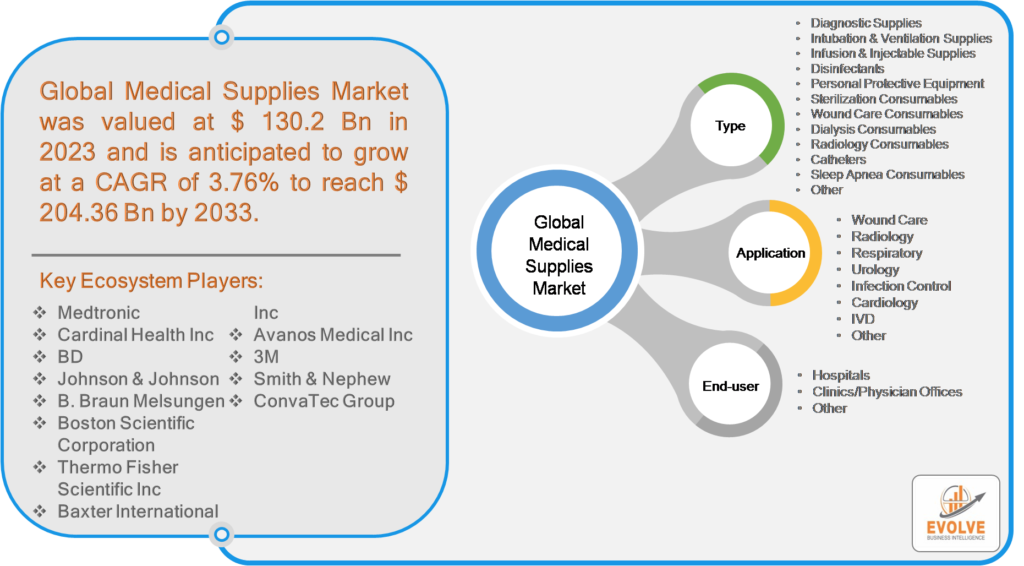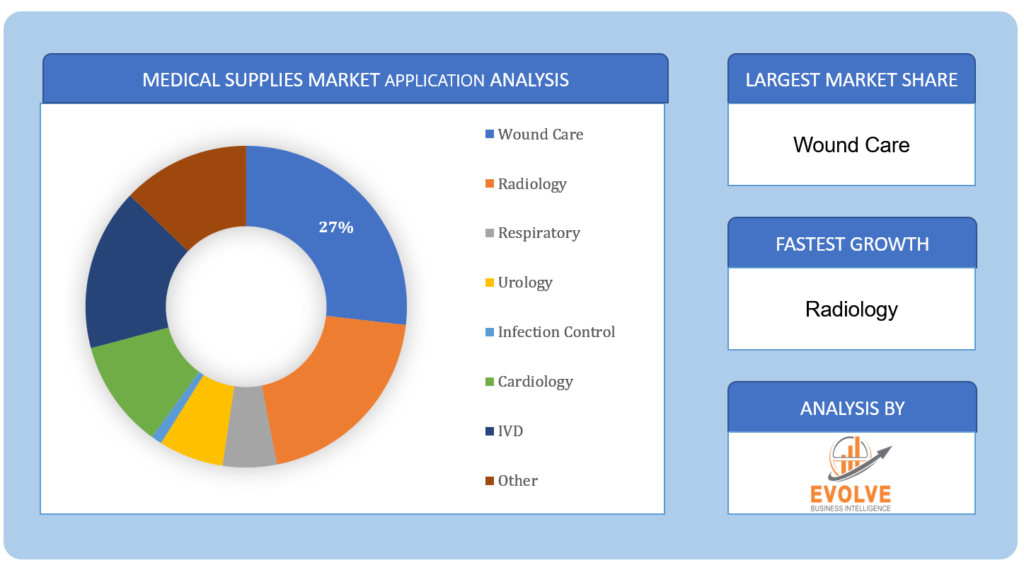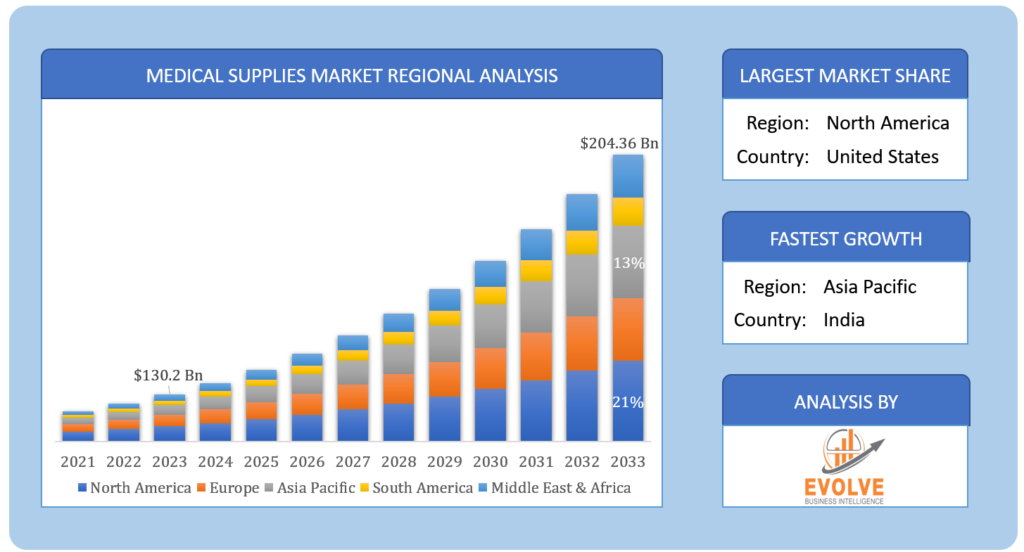Medical Supplies Market Overview
Medical Supplies Market Size is expected to reach USD 204.36 Billion by 2033. The Medical Supplies industry size accounted for USD 130.2 Billion in 2023 and is expected to expand at a compound annual growth rate (CAGR) of 3.76% from 2023 to 2033.Medical supplies are a broad range of products and equipment utilized for diagnostic, treatment, and preventive purposes related to illnesses, injuries, and diseases. These supplies have a varying degree of complexity, ranging from simple items such as bandages and syringes to advanced equipment such as ventilators and MRI machines. Medical supplies find their use in diverse settings such as hospitals, clinics, doctors’ offices, laboratories, and even in-home care settings. Medical supplies include surgical instruments, diagnostic tests, medical gloves, catheters, and respiratory equipment. The quality and reliability of medical supplies are critical to ensure patient safety and achieving successful medical outcomes.
COVID-19 Impact and Post-COVID Scenario
The COVID-19 pandemic has certainly had a positive impact on the pharmaceutical industry, including the Medical Supplies market. The COVID-19 pandemic has led to a surge in demand for PPE, including masks, gloves, gowns, and face shields, as healthcare workers and other essential personnel require adequate protection to prevent the spread of the virus. This increased demand has led to a significant increase in the production and sales of PPE, resulting in revenue growth for many companies that manufacture and distribute these products.Similarly, the pandemic has also led to a surge in demand for medical devices, such as ventilators and oxygen concentrators, which are critical for treating severe COVID-19 cases. This increased demand has led to an increase in the production and sales of these devices, resulting in revenue growth for many medical device companies.
Global Medical Supplies Market Growth Factors
Increasing prevalence of chronic diseases
The rise in chronic diseases has led to an increased demand for medical supplies such as diagnostic equipment, therapeutic devices, and surgical instruments. For instance, cancer diagnosis and treatment often involve the use of imaging equipment such as computed tomography (CT) scanners, magnetic resonance imaging (MRI) machines, and X-ray machines, as well as surgical instruments such as scalpels, forceps, and retractors. Similarly, the management of diabetes may require the use of insulin pumps, blood glucose monitors, and lancets.Furthermore, cardiovascular diseases such as heart disease and stroke are a leading cause of death globally. These conditions often require the use of medical devices such as stents, pacemakers, and defibrillators, as surgical instruments such as catheters and guidewires.
Global Medical Supplies Market Restraining Factors
Limited healthcare infrastructure can result in a lack of healthcare facilities, healthcare providers, and medical supply distribution networks. This can make it difficult for people living in rural areas to access the medical supplies they need. For instance, medical devices and equipment such as X-ray machines, MRI scanners, and dialysis machines may not be available in remote areas, which means that patients may need to travel long distances to receive treatment.In addition, the limited availability of medical supplies can also lead to disparities in access to healthcare between urban and rural areas. In urban areas, medical supplies are often more readily available, and healthcare infrastructure is generally better developed. This means that people living in urban areas may have better access to medical supplies than those living in rural areas.
Global Medical Supplies Market Opportunity Analysis
The increasing use of digital technologies in healthcare
The increasing use of digital technologies in healthcare presents a significant opportunity for the medical supplies market. Digital health technologies such as telemedicine and mobile health (mHealth) are transforming the way healthcare is delivered and accessed, and medical supplies such as wearables, remote patient monitoring devices, and mobile health apps are playing an increasingly important role in improving patient outcomes and reducing healthcare costs.Telemedicine allows patients to receive medical consultations and treatment remotely, which can be particularly beneficial for patients living in rural or remote areas, as well as for patients with mobility or transportation issues. Medical supplies such as telemedicine equipment and software are critical to enabling telemedicine services.
Global Medical Supplies Market Segment Analysis
 The Infusion & Injectable Supplies segment is expected to hold the largest market share in 2023
The Infusion & Injectable Supplies segment is expected to hold the largest market share in 2023
Based on the Type, the market is segmented based on Diagnostic Supplies, Intubation & Ventilation Supplies, Infusion & Injectable Supplies, Disinfectants, Personal Protective Equipment, Sterilization Consumables, Wound Care Consumables, Dialysis Consumables, Radiology Consumables, Catheters, Sleep Apnea Consumables, Other. The largest market share is anticipated to go to the Infusion & Injectable Supplies segment.The growth of this segment is being driven by factors such as the increasing prevalence of chronic diseases, the rising demand for home healthcare services, and the increasing use of infusion therapy in hospitals and other healthcare facilities.
The Wound Care segment is expected to hold the largest market share in 2023
Based on Application, the market has been divided intoWound Care, Radiology, Respiratory, Urology, Infection Control, Cardiology, IVD, and Others.The Wound Care segment is expected to hold the largest market share in the Market, due tothe increasing prevalence of chronic wounds, such as diabetic foot ulcers and pressure ulcers, the rising incidence of surgical procedures, and the growing demand for advanced wound care products that can promote faster healing and reduce the risk of infection.
The Hospitals segment is expected to hold the largest market share in 2023
Based on End-user, the market has been divided into Hospitals, Clinics/Physician Offices, Other.The market is projected to see significant growth in the Hospitals segment due to the increasing demand for healthcare services, advancements in medical technology, government initiatives, and increasing healthcare expenditure.
Global Medical Supplies Market, Segmental Chart

Regional Analysis
Based on region, the market has been divided into North America, Europe, Asia-Pacific, theMiddle East & Africa, and Latin America. The area of Europe is anticipated to dominate the market for the usage of Medical Supplies, followed by those in Asia-Pacific and North America.
Regional Coverage:
- North America
- US
- Canada
- Mexico
- Europe
- UK
- Germany
- France
- Italy
- Spain
- Benelux
- Russia
- Rest of Europe
- Asia Pacific
- China
- Japan
- South Korea
- Indonesia
- Australia
- Malaysia
- Thailand
- India
- Rest of Asia Pacific
- Latin America
- Brazil
- Argentina
- Rest of Latin America
- Middle East & Africa
- Saudi Arabia
- UAE
- Egypt
- South Africa
- Rest of Middle East & Africa
Europe Market
The Europe region is the leading market for Medical Supplies. Numerous elements, including the rising incidence of chronic illnesses, an aging population, and developments in medical technology, are responsible for the expansion of the medical supply business in Europe. Additionally, Europe has a highly developed healthcare system, good reimbursement practices, and a robust regulatory environment, all of which contribute to the market expansion for medical supplies.Furthermore, there are several significant market participants, such as Medtronic, Becton, Dickinson and Company, and Siemens Healthineers, among others, making the European medical supply industry extremely competitive. These businesses make significant R&D investments to create cutting-edge products, which fuels the market’s expansion.
Asia Pacific Market
The Asia-Pacific region is expected to have the fastest CAGRfor the medical supplies market globally.This growth is attributed to several factors, such as the increasing prevalence of chronic diseases, a growing aging population, rising healthcare spending, and increasing demand for quality healthcare. Additionally, the increasing awareness of healthcare and the growing middle class in countries such as China and India are contributing to the growth of the medical supplies market in the Asia-Pacific region.Moreover, the Asia-Pacific region is witnessing significant investments in healthcare infrastructure, which is expected to boost the demand for medical supplies in the region. Additionally, several initiatives by governments and private organizations to improve healthcare access, affordability, and quality are further driving the growth of the medical supplies market in the region.
Competitive Landscape
The competitive landscape includes key players (tier 1, tier 2, and local) having a presence across the globe. Companies such as Johnson & Johnson, B. Braun Melsungen, Boston Scientific Corporation, and Thermo Fisher Scientific Incare some of the leading players in the global Medical SuppliesIndustry. These players have adopted partnership, acquisition, expansion, and new product development, among others as their key strategies.
Key Market Players:
- Medtronic
- Cardinal Health Inc
- Datasea Inc
- Johnson & Johnson
- Braun Melsungen
- Boston Scientific Corporation
- Thermo Fisher Scientific Inc
- Baxter International Inc
- Avanos Medical Inc
- 3M
- Smith & Nephew
- ConvaTec Group
Market Share Acquisition Strategies: Analysis of Key Approaches Employed by Top Players
On March2022, Datasea Inc. introduced Ultrasonic Sound Sterilisation and Antivirus Equipment aimed at various application situations, with plans to penetrate the US market with acoustic intelligence solutions. The Ultrasonic Sound Sterilisation and Antivirus Equipment employ cutting-edge acoustic intelligence-powered disinfection that has been shown to cleanse the air while also reducing germs and viruses.
On March 2021, AESCULAP Inc announced the release of the AESCULAP Aicon Sterile Container System. The new container incorporates characteristics that aid in the streamlining of procedures and the reduction of the danger of wet sets.
Report Scope:
Global Medical Supplies Market, by Type
- Diagnostic Supplies
- Intubation & Ventilation Supplies
- Infusion & Injectable Supplies
- Disinfectants
- Personal Protective Equipment
- Sterilization Consumables
- Wound Care Consumables
- Dialysis Consumables
- Radiology Consumables
- Catheters
- Sleep Apnea Consumables
- Other
Global Medical Supplies Market, by Application
- Wound Care
- Radiology
- Respiratory
- Urology
- Infection Control
- Cardiology
- IVD
- Other
Global Medical Supplies Market, by End-user
- Hospitals
- Clinics/Physician Offices
- Other
Medical Supplies Market Synopsis:
| PARAMETER | VALUE |
Market Size | · 2023: USD 130.2 Billion· 2033: USD 204.36 Billion |
Growth Rate | · First 5 Years CAGR (2023–2028): XX%· Last 5 Years CAGR (2028–2033): XX%· 10 Years CAGR (2023–2033): 3.76% |
Key Market Drivers | · A growing number of older people people require medical care· Increasing prevalence of chronic diseases |
Key Market Restraints | · Stringent regulatory requirements· Limited healthcare access |
Market Opportunities | · Increasing demand for home healthcare· Growing healthcare infrastructure in developing countries |
Key Market Players | · Medtronic· Cardinal Health Inc· BD· Johnson & Johnson· B. Braun Melsungen· Boston Scientific Corporation· Thermo Fisher Scientific Inc· Baxter International Inc· Avanos Medical Inc· 3M· Smith & Nephew· ConvaTec Group |
REPORT CONTENT BRIEF:
- High-level analysis of the current and future Medical SuppliesIndustry trends and opportunities
- Detailed analysis of current market drivers, restraining factors, and opportunities analysis in the future
- Historical market size for the year 2021, and forecast from 2023 to 2033
- Medical Supplies market share analysis for each segment
- Competitor analysis with a comprehensive insight into its product segment, financial strength, and strategies adopted.
- Identifies key strategies adopted by the key players including new product development, mergers and acquisitions, joint ventures, collaborations, and partnerships.
- To identify and understand the various factors involved in the global Medical Supplies market affected by the pandemic
- To provide year-on-year growth from 2022 to 2033
- To provide short-term, long-term, and overall CAGR comparison from 2022 to 2033.
- Provide Total Addressable Market (TAM) for the Global Medical Supplies Market.







